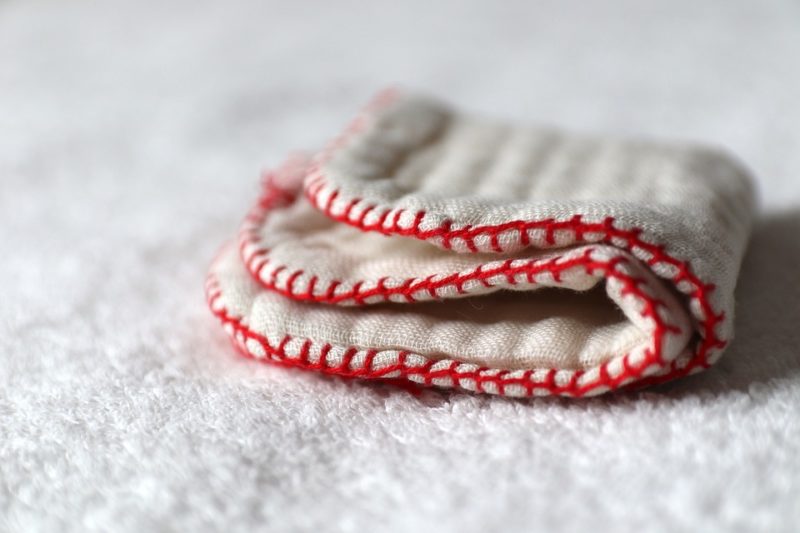We will discuss how to do an overcast stitch on a sewing machine by teaching you the proper use of the overcast feet. Did you know that there are various kinds of overcast feet as well?
Some stitches often used interchangeably with the overcast stitch are the blanket stitch and whipstitch. Therefore, this article also compares these stitches to help you identify the proper ways to use them in projects.

And since the overcast stitch is often for finishing seams, why not read how to serge with a sewing machine as well? In addition, it contains tips for overlocking and other ways to finish fabric edges when sewing.
How To Do An Overcast Stitch On A Sewing Machine With An Overcast Foot
- Refer to the manual of the specific sewing machine model you have on how to replace its foot
- Remove the current presser foot and install the overcast foot securely
- Use the overcast foot that is compatible with your model; it is also sometimes called an overlocker foot or overedge foot
- Determine the overcast foot as the attachment with a center bar responsible for wrapping the thread around the fabric edge to keep it from curling
- Set the sewing machine to wide zigzag stitch since it can bind the fabric edges
- Some sewing machines also have an overedge stitch for use with the overcast foot
- Test your selected stitch length and thread tension on a piece of scrap fabric to know the necessary adjustments
- Place the material under the needle of the sewing machine so that its edge is against the guide
- Check if the needle won’t hit the center bar when sewing as it can break
- Sew slowly and precisely
Types Of Overcast Presser Feet
-
Overcast foot C
The overcast foot C has two wires that hold the fabric edges when sewing, making them perfect for overcasting without the risk of the machine skipping stitches.
-
Overcast foot G
The overcast foot G also helps keep the fabric edge from curling because it has a metal bar and a guide that aids in straight sewing.
-
Overcast foot M
The overcast foot M has three wires instead of two to keep fabric edge puckering and ensure an overlocking finish that looks professionally made.
If you’re new to sewing, read about sewing machine attachments and how to use them for various presser feet types.
What Is A Machine Overcast Stitch?
A machine overcast stitch is a technique of overedge or overlocking stitches on the fabric edge with a sewing machine using an overcast foot. This stitch makes an excellent alternative for finishing seams professionally without a serger.
To do the overcast stitch on the sewing machine, you need the overcast foot and then set the machine to the overcast stitch. Then, follow the stitch width, length, and thread tension indicated in the manual.
Alternatives to machine overcast stitch
- Cut the seams with pinking shears to prevent the fabric from fraying or curling
- Turn the fabric edges under and sew with a straight stitch to make strong seams
- Finish the seams with the zigzag stitch to stabilize the fabric edge
- Use a bias tape to add design and also finish the seam
Do You Backstitch When Overcasting?
When you make overcast stitches to finish fabric edges, you don’t have to backstitch. After all, remember that overcasting stitches won’t unravel easily compared to other stitches.
Backstitching is only necessary when the beginning and end of the seam stitching line are prone to stress.
Do you backstitch when sewing a zigzag stitch?
Backstitching zigzag stitches are essential to prevent them from unraveling later on. You can do this with a regular presser foot and the swing machine’s reverse function when starting and ending zigzag stitches.
Is An Overcast Stitch The Same As A Blanket Stitch?
An overcast stitch is not the same as a blanket stitch. However, it is often used as an alternative, especially when you can’t overcast stitch by hand.
The blanket stitch can be distinguished from an overcast stitch because it has a thread along the edge. And for uses, it would be perfect when you can’t turn the fabric edge when finishing the seam.
Read about how to do a blanket stitch on a sewing machine to know more.
What Does Whip Stitch Look Like?
The whipstitch is the same as the overcast stitch, and they can be mentioned interchangeably. These stitches have the thread around the fabric edge to strengthen the seam and prevent fraying.
Another way the overcast stitch is called the whipstitch is when you sew fabric pieces together or attach appliques. Here is what is a whip stitch in sewing to understand its uses and importance.
When Would You Use An Overcast Stitch?
- For finishing fabric edges and keeping fabric from fraying
- For professional-looking seams
- For closing openings
- For holding pieces together
- For appliques
Conclusion
And that’s it! We just learned how to do an overcast stitch on a sewing machine and discovered it’s as easy as attaching the overcast foot and selecting the overcast stitch.
However, you can also use the wide zigzag stitch or other alternatives for finishing seams. It’s worth emphasizing that overcasting stitches won’t require backstitching as well.
We hope this was helpful; leave us a question if you still have any.
